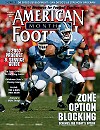AMERICAN FOOTBALL MONTHLY THE #1 RESOURCE FOR FOOTBALL COACHES
Article CategoriesAFM Magazine
|
The Situation© More from this issueDavid Hartman, Head Coach Crossroads Youth Football League, Victoria (TX) AFM subscriber since 2002 44Base Crash Laser 54, Cover 1
Our play LASER 54 calls for 6-man pressure involving a dog by the LOU and ROB inside linebackers thru the 5 and 4 holes, respectively. For simplicity, when calling blitzes, we utilize a mirror of our offensive hole numbering system so players on both sides of the ball only have to learn a single set of numbers. Since both ILB’s are responsible for the first back out to their side, ROB should pull up his rush and slide outside as the near back ....The full article can only be seen by subscribers. Subscribe today!
|
|
||||||||
| HOME |
MAGAZINE |
SUBSCRIBE | ONLINE COLUMNISTS | COACHING VIDEOS |
Copyright 2025, AmericanFootballMonthly.com
All Rights Reserved






